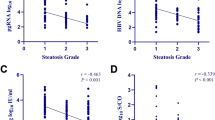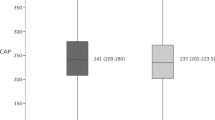Abstract
Background and Aims
The interaction between hepatitis B virus (HBV) infection and hepatic steatosis remains unclear. We aimed to explore the trend of prevalence of hepatic steatosis and its relationship with virological factors in HBV infected patients.
Methods
Consecutive untreated patients with chronic HBV infection at Shunde Hospital between 2002 and 2011 were included. Quantification of HBV replication markers was performed by enzyme immunoassay, real-time polymerase chain reaction assay and immunohistochemical staining. Hepatic steatosis was defined as at least 5 % hepatocytes affected.
Results
A total of 3,212 patients (2,574 men) with a mean age of 32 ± 9.3 years were analyzed. Serological testing showed detectable HBsAg in all, HBeAg in 63.8 % and HBV DNA in 78.4 % of patients. Liver biopsies demonstrated HBsAg- and HBcAg-positive immunostaining in 96.6 and 71 % patients, respectively. Hepatic steatosis was present in 554 (17.3 %) patients, with annual prevalence increased over time from 8.2 to 31.8 % (trend analysis, x 2 = 51.657, P < 0.001). Compared to patients without steatosis, the percentages of serum HBeAg-positive and detectable HBV DNA, and intrahepatic HBsAg- and HBcAg-positive staining were decreased in steatosis patients (all P < 0.001). Adjusted for age and gender, intrahepatic HBsAg-positive staining remained as an independent factor associated with lower risk of steatosis (adjusted odds ratio 0.90, 95 % confidence interval 0.835, 0.971) in multivariate analysis.
Conclusions
Hepatic steatosis in HBV infected patients has been raging over the past decade, and it is negatively associated with intrahepatic expression of HBsAg. Lifestyle intervention may be needed to halt the onset of steatosis in chronic HBV infection.





Similar content being viewed by others

References
Liu J, Fan D. Hepatitis B in China. Lancet. 2007;369:1582–1583.
Jia JD, Yao GB. Achieving ultimate control of hepatitis B infection in China: progress and challenges. J Viral Hepat. 2010;17:2–3.
Fan JG, Farrell GC. Epidemiology of non-alcoholic fatty liver disease in China. J Hepatol. 2009;50:204–210.
Farrell GC, Chitturi S, Lau GK, et al. Guidelines for the assessment and management of non-alcoholic fatty liver disease in the Asia-Pacific region: executive summary. J Gastroenterol Hepatol. 2007;22:775–777.
Kleiner DE, Brunt EM, Van Natta M, et al. Design and validation of a histological scoring system for on-alcoholic fatty liver disease. Hepatology. 2005;41:1313–1321.
Fan JG, Chitturi S. Hepatitis B and fatty liver: causal or coincidental? J Gastroenterol Hepatol. 2008;23:679–681.
Machado MV, Oliveira AG, Cortez-Pinto H. Hepatic steatosis in hepatitis B virus infected patients: meta-analysis of risk factors and comparison with hepatitis C infected patients. J Gastroenterol Hepatol. 2011;26:1361–1367.
Shen L, Fan JG, Shao Y, et al. Prevalence of nonalcoholic fatty liver among administrative officers in Shanghai: an epidemiological survey. World J Gastroenterol. 2003;9:1106–1110.
Shi J, Fan JG, Wu R, et al. Prevalence and risk factors of hepatic steatosis and its impact on liver injury in Chinese patients with chronic hepatitis B infection. J Gastroenterol Hepatol. 2008;23:1419–1425.
Wong VW, Wong GL, Chu WC, et al. Hepatitis B virus infection and fatty liver in the general population. J Hepatol. 2012;56:533–540.
Rastogi A, Sakhuja P, Kumar A, et al. Steatosis in chronic hepatitis B: prevalence and correlation with biochemical, histologic, viral, and metabolic parameters. Indian J Pathol Microbiol. 2011;54:454–459.
Zhang Z, Pan Q, Duan XY, et al. Fatty liver reduces hepatitis B virus replication in a genotype B hepatitis B virus transgenic mice model. J Gastroenterol Hepatol. 2012;27:1858–1864.
Wang GS, Wang MM, Xie QL, et al. Expression and clinical significance of HBsAg and HBcAg in hepatocytes in chronic hepatitis B. Zhonghua Gan Zang Bing Za Zhi. 2004;12:287–289.
Szczepaniak LS, Nurenberg P, Leonard D, et al. Magnetic resonance spectroscopy to measure hepatic triglyceride content: prevalence of hepatic steatosis in the general population. Am J Physiol Endocrinol Metab. 2005;288:E462–E468.
Kim CH, Kallman JB, Bai C, et al. Nutritional assessments of patients with non-alcoholic fatty liver disease. Obes Surg. 2010;20:154–160.
Luo B, Wang Y, Wang K. Association of metabolic syndrome and hepatitis B infection in a Chinese population. Clin Chim Acta. 2007;380:238–240.
Jan CF, Chen CJ, Chiu YH et al. A population-based study investigating the association between metabolic syndrome and hepatitis B/C infection (Keelung Community-based Integrated Screening study No. 10). Int J Obes (Lond) 2006; 30:794–799.
Zhang Z, Pan Q, Duan XY, Shi JP, Fan JG. Establishment and identification of non-alcoholic fatty liver disease in chronic hepatitis B virus infected mice. Zhonghua Gan Zang Bing Za Zhi. 2011;19:658–663.
Thoma C, Day CP, Trenell MI. Lifestyle interventions for the treatment of non-alcoholic fatty liver disease in adults: a systematic review. J Hepatol. 2012;56:255–266.
Chu CM, Lin DY, Liaw YF. Does increased body mass index with hepatic steatosis contribute to seroclearance of hepatitis B virus surface antigen in chronic HBV infection? Int J Obes. 2007;31:871–875.
Chu CM, Lin DY, Liaw YF. Clinical and virological characteristics post HBsAg seroclearance in hepatitis B virus carriers with hepatic steatosis versus those without. Dig Dis Sci. 2013;58:275–281.
Fung J, Yuen MF, Lai CL. The role of steatosis in HBsAg seroclearance for patients with chronic hepatitis B infection: fact or fiction? Dig Dis Sci. 2013;58:20–22.
Lim JK, Nguyen MH. The role of hepatic steatosis in chronic hepatitis B infection. Curr Hepatitis Rep. 2011;10:134–141.
Shi JP, Xun YH, Su YX, et al. Metabolic syndrome and severity of fibrosis in patients with chronic hepatitis B virus infection or nonalcoholic fatty liver disease. J Microbiol Res. 2011;5:481–485.
Wong GL, Wong VW, Choi PC, et al. Metabolic syndrome increases the risk of liver cirrhosis in chronic hepatitis B. Gut. 2009;58:111–117.
Stepanova M, Rafiq N, Younossi ZM. Components of metabolic syndrome are independent predictors of mortality in patients with chronic liver disease: a population-based study. Gut. 2010;59:1410–1415.
Welzel TM, Graubard BI, Zeuzem S, et al. Metabolic syndrome increases the risk of primary liver cancer in the United States: a study in the SEER-Medicare database. Hepatology. 2011;54:463–471.
Takamatsu S, Noguchi N, Kudoh A, et al. Influence of risk factors for metabolic syndrome and non-alcoholic fatty liver disease on the progression and prognosis of hepatocellular carcinoma. Hepatogastroenterology. 2008;55:609–614.
Thompson AJ, Nguyen T, Iser D, et al. Serum hepatitis B surface antigen and hepatitis B e antigen titers: disease phase influences correlation with viral load and intrahepatic hepatitis B virus markers. Hepatology. 2010;51:1933–1944.
Manesis EK, Papatheodoridis GV, Tiniakos DG, et al. Hepatitis B surface antigen: relation to hepatitis B replication parameters in HBeAg-negative chronic hepatitis B. J Hepatol. 2011;55:61–68.
Lin LY, Wong VW, Zhou HJ, et al. Relationship between serum hepatitis B virus DNA and surface antigen with covalently closed circular DNA in HBeAg-negative patients. J Med Virol. 2010;82:1494–1500.
Acknowledgments
We wish to thank all patients and medical staff who participated in the study. This work was financially supported by the State Key Development Program for Basic Research of China (2012CB517500), the Program of the Shanghai Committee of Science and Technology (09140903500 &10411956300), the National Natural Science Foundation of China (81070322 &81270491), and the 100 Talents Program of the Shanghai Board of Health (XBR2011007).
Conflict of interest
None.
Author information
Authors and Affiliations
Corresponding author
Rights and permissions
About this article
Cite this article
Wang, MM., Wang, GS., Shen, F. et al. Hepatic Steatosis Is Highly Prevalent in Hepatitis B Patients and Negatively Associated with Virological Factors. Dig Dis Sci 59, 2571–2579 (2014). https://doi.org/10.1007/s10620-014-3180-9
Received:
Accepted:
Published:
Issue Date:
DOI: https://doi.org/10.1007/s10620-014-3180-9



